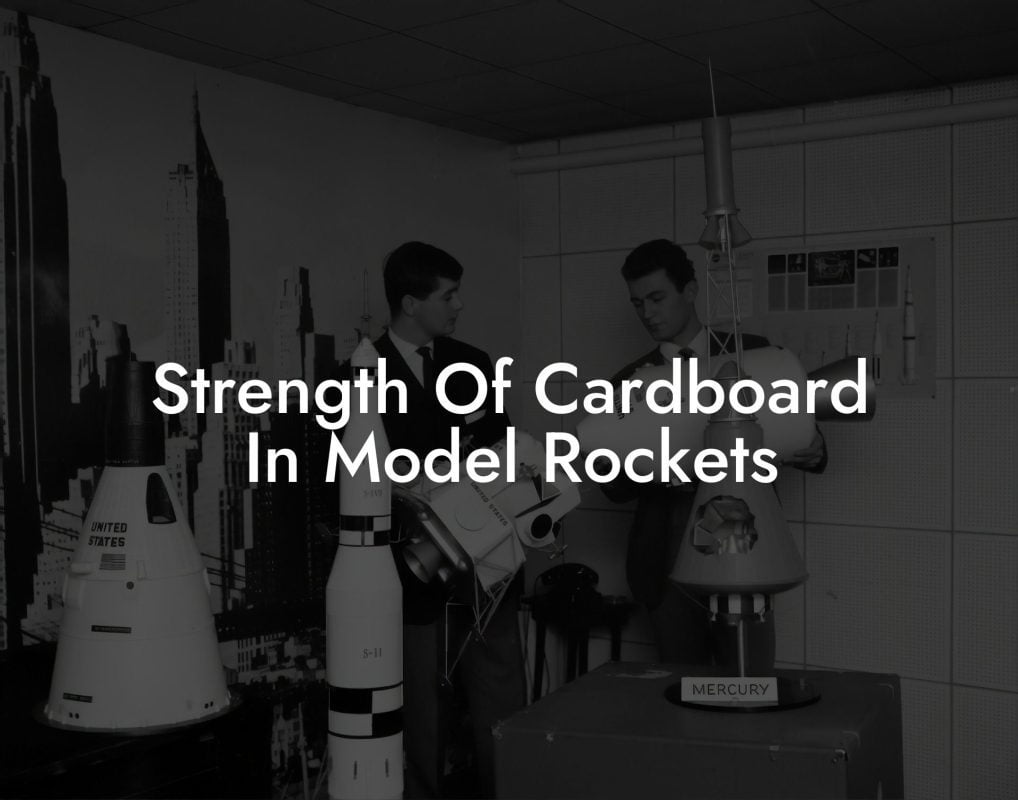Imagine soaring to new heights with your very own model rocket, defying gravity and pushing the limits of innovation. Welcome to the world of model rockets, where creativity meets science and adventure awaits.
Quick Links to Useful Sections
- What Are Model Rockets?
- The Science Behind Model Rockets
- Types of Model Rockets
- Beginner-Friendly Models
- Mid-Power Rockets
- High-Power Rockets
- Scale Models
- Getting Started with Model Rockets
- Tips and Tricks for Model Rocket Success
- Resources and Community Support: Your Next Steps
- Frequently Asked Questions: Model Rockets 101
What Are Model Rockets?
Model rockets are scaled-down versions of real rockets, designed for recreational and educational purposes. They typically range from simple, beginner-friendly kits to complex, high-performance models that mimic the designs of actual spacecraft.
These miniature marvels can be powered by various propulsion systems, including solid-fuel motors, liquid-fuel engines, and even hybrid engines that combine different fuel sources. Whether you're a seasoned enthusiast or just starting out, model rockets offer an exciting way to explore the world of aerospace engineering and space exploration.
The Science Behind Model Rockets
Model rockets operate on the same principles as their full-scale counterparts, relying on the fundamental laws of physics and aerodynamics to achieve flight. The four key forces of flight – lift, weight, thrust, and drag – come into play as the rocket soars through the air.
- Lift: The upward force created by the shape of the rocket's body and fins, counteracting the weight of the vehicle.
- Weight: The downward force exerted by the rocket's mass, opposing the lift force.
- Thrust: The forward force generated by the rocket's propulsion system, propelling the vehicle upward.
- Drag: The backward force caused by air resistance, slowing the rocket's ascent.
By understanding and balancing these forces, model rocket enthusiasts can design and build more efficient, stable, and high-performing rockets.
Looking For The Best Model Rocket Kits? You'll Love These:
Types of Model Rockets
The world of model rockets is incredibly diverse, with various categories and subcategories catering to different skill levels, interests, and preferences.
Beginner-Friendly Models
Ideal for newcomers to the hobby, these entry-level rockets are easy to assemble and launch, often featuring pre-assembled components and simple designs.
Mid-Power Rockets
Suitable for intermediate enthusiasts, mid-power rockets offer more complexity and performance, with larger motors and more sophisticated designs.
High-Power Rockets
For experienced modelers, high-power rockets represent the pinnacle of performance, featuring advanced materials, complex systems, and incredible altitudes.
Scale Models
These highly detailed models replicate actual spacecraft, missiles, or launch vehicles, often with intricate features and realistic paint schemes.
Getting Started with Model Rockets
If you're eager to join the model rocket community, here are some essential steps to get you started:
- Choose Your Rocket: Select a model that suits your skill level and interests, considering factors like complexity, performance, and cost.
- Understand Safety Guidelines: Familiarize yourself with local regulations, safety protocols, and best practices for launching and handling model rockets.
- Prepare Your Launch Site: Find a safe, open area with minimal obstacles and wind, ensuring a successful and enjoyable launch experience.
- Join a Community: Connect with local model rocket clubs, online forums, or social media groups to learn from experienced enthusiasts, share knowledge, and stay updated on the latest trends and products.
By following these steps, you'll be well on your way to exploring the exciting world of model rockets.
Tips and Tricks for Model Rocket Success
To take your model rocketing experience to the next level, consider these expert tips and tricks:
- Use High-Quality Components: Invest in durable, reliable materials and parts to ensure consistent performance and minimize failures.
- Optimize Your Design: Experiment with different shapes, sizes, and configurations to improve stability, efficiency, and overall performance.
- Master Your Launch Technique: Develop a smooth, consistent launch style to minimize stress on the rocket and maximize altitude.
- Monitor Weather Conditions: Launch during favorable weather conditions, avoiding strong winds, rain, or extreme temperatures.
By incorporating these tips into your model rocketing routine, you'll be able to achieve better results, improve your skills, and enjoy a more rewarding experience.
Resources and Community Support: Your Next Steps
As you continue to explore the world of model rockets, remember that you're not alone. Tap into these valuable resources and communities to stay informed, learn from others, and share your own experiences:
- National Association of Rocketry (NAR): A leading organization for model rocket enthusiasts, offering resources, guidance, and community support.
- Model Rocket Forums: Online discussion boards and social media groups dedicated to model rocketry, where you can connect with fellow enthusiasts, ask questions, and share knowledge.
- Local Model Rocket Clubs: Join or form a local club to meet like-minded individuals, participate in launches, and learn from experienced modelers.
- Model Rocket Manufacturers: Visit websites and social media channels of prominent model rocket manufacturers to stay updated on new products, tutorials, and expert advice.
By leveraging these resources and communities, you'll be able to accelerate your learning, improve your skills, and enjoy a more rewarding model rocketing experience.
Frequently Asked Questions: Model Rockets 101
Here are some frequently asked questions about model rockets, covering the basics and beyond:
1. What is the highest altitude a model rocket can reach?
The highest altitude recorded by a model rocket is over 100,000 feet (30,480 meters), achieved by a high-power rocket in 2016.
2. Are model rockets safe?
When handled and launched properly, model rockets are safe. However, it's essential to follow safety guidelines, wear protective gear, and ensure a safe launch environment.
3. How much do model rockets cost?
Model rocket prices vary greatly, ranging from under $10 for beginner-friendly kits to over $1,000 for high-performance, complex models.
4. Can I build my own model rocket?
Yes, you can design and build your own model rocket from scratch, using various materials and components. This approach requires more expertise and creativity but can be highly rewarding.
5. Are model rockets suitable for children?
Yes, model rockets can be a fun and educational hobby for children, teaching them about science, technology, engineering, and mathematics (STEM) concepts. However, adult supervision is recommended, especially for younger children.
Looking For The Best Model Rocket Kits? You'll Love These:
Useful Interruption: Dive deeper into the world of Model Rockets with our most popular sections. If there is anything you think is missing or anything you would love for us to write about, just give us a shout.
- Getting Started & Basics With Model Rockets
- Model Rocket Design, Build & Customization
- Model Rocket Propulsion & Engine Technology
- Model Rocket Launch Techniques & Recovery
- Model Rocket Advanced Rocketry & Innovations
- Model Rocket DIY and Customization
- Model Rocket Equipment Reviews & Digital Tools
- Community, Competitions & Education
- Model Rocket Troubleshooting & FAQs
- Model Rocket Bonus/Seasonal & Niche Topics
A group of model rocket enthusiasts gathered at a field for their weekly launch event. Among them was Dave, a seasoned builder known for pushing the limits of hobby rocketry. This time, he had outdone himself.
“Ladies and gentlemen,” Dave announced, dramatically pulling a cloth off his latest creation, “I present to you: The Kraken!”
The crowd gasped. This wasn’t just a model rocket—it was a monster. The thing stood 8 feet tall, had six clustered engines, and was covered in enough duct tape to qualify as a classified aerospace project.
“Dave,” muttered Steve, the cautious safety officer, “Have you, uh… done the math on this?”
“Math?” Dave scoffed. “I built it in my garage at 3 a.m. with parts from eBay. This is an art piece, Steve.”
The countdown began.
5…
4…
3…
2…
1…
The engines ignited with a BOOM, and The Kraken shot up… kind of. It immediately did a violent barrel roll, narrowly missing the spectators before skyrocketing at an angle that could only be described as “legally questionable.”
The crowd collectively ducked as The Kraken flew straight over the adjacent cornfield, where Old Man Jenkins, the grumpiest farmer in town, was minding his business.
KABOOM!
The rocket disappeared behind the barn. A moment later, a flaming piece of Estes igniter wire landed at Steve’s feet. The silence was deafening.
And then—an unmistakable sound echoed across the field.
Jenkins’ shotgun being cocked.
“DAVE!!!” Steve shouted. “RUN.”
And that was the day Dave invented the first-ever biologically powered rocket booster: pure adrenaline.
To this day, nobody knows where The Kraken landed, but legend has it, it still haunts the skies, terrifying unsuspecting drones and low-flying birds.















